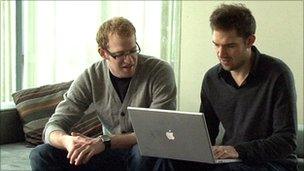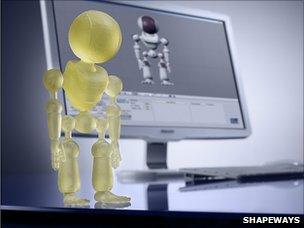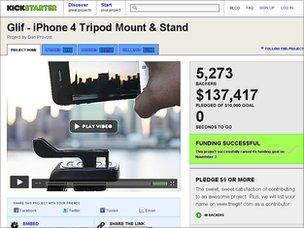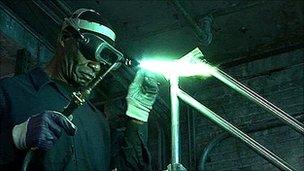Manufacturing the dream: Game changing new production
- Published
Dream maker: New manufacturing techniques make product design an accessible reality
At one time or another many of us have had a great idea for a product. So good, we can see it clearly in our heads.
Unfortunately that is usually where it stays.

Glif co-founders Dan Provost and Tom Gerhardt raised $137,000 on Kickstarter to fund the project.
But two friends from Long Island City in New York have taken their simple concept and turned it into something tangible, just in time for Christmas.
Dan Provost and Tom Gerhardt realised that Apple's iPhone 4 with its improved camera technology deserved its own tripod mount. So they invented The Glif, which also doubles as a multi-directional prop for holding the iPhone at various angles during video calls and movie watching sessions.
Years ago The Glif prototype might have been modelled from a lump of clay or chiselled from a block of wood. It would likely have taken experts and a sizeable cash investment to turn it into a technically perfect specimen suitable for a full blown production run.
Not anymore.
The Glif was designed in less than three weeks using just a laptop and a full-featured three-dimensional (3D) design software program, although anybody can now design almost anything using free software such as Google's Sketchup.
3D printing
Co-designer Mr Provost explains the development process, which is fast and easy.
"We did iteration after iteration and did between five and 10 samples using Shapeways, just tweaking the design each time," he says.
Shapeways is a company on the cutting edge of manufacturing. A three-dimensional design can be submitted to it over the internet and it can "print" the design layer by layer out of plastics or metal, and send it back to you.
The potential for this kind of production is enormous, though the real breakthrough will come when individual customisable components or pieces are the same cost to produce as mass runs.
It is hoped that the savings that companies will realise in the future from geographically convenient 3D printing sites will be substantial, thanks to a reduction of shipping costs.
Another benefit is that inventory can be kept to zero if required. Shapeways will host your online products within their website so components can be made on demand, one by one, as customer orders come in.
Shapeways chief executive Peter Weijmarshausen is also keen to point out there is another advantage of selling straight from the virtual factory conveyor belt.

Three dimensional printing means new products can be produced quickly and cheaply
"It enables evolutionary design," he says.
"It used to be that you have a prototype and you get investors, you get 100,000 copies and you start selling.
"You get a lot of feedback from the market and you make version two. With new production techniques you get feedback and adapt your design days later."
Money, money, money
Meanwhile, for The Glif to go any further it needed some money behind it. Not much, but enough to get it off the screen and into about 500 homes.
It was very much a dream and neither Mr Provost nor Mr Gerhardt thought it would be easy. But the solution they found turned out to be incredibly attractive and gave them a bank account that ballooned to 13 times their expectations.
They posted their project on Kickstarter.com, a website that gives new ideas a financial target and an audience to reach it. Anyone can contribute to a project, but unless the entire funding goal is met within 30 days, it evaporates into cyberspace as quickly as it arrived.
Yancy Strickler, co-founder of Kickstarter.com, says the impact of a campaign can be instant.

Kickstarter allows anyone to crowdsource funding for their project.
"It's a way for you to know from the beginning how much interest there is, so you can either fail quickly or succeed immediately. Either one is better than struggling for years and not knowing either way."
Not only did they have a simple, straightforward product but Mr Provost and Mr Gerhardt produced some personable video content to help sell their idea. Viewers essentially bought the product prior to production for $20 (£13) a time. And it worked.
Mr Gerhardt, Glif co-designer, says they just sat down with a video camera and appealed to their audience in a very blunt honest way.
"Within 24 hours we'd already raised about $35,000. Our goal was $10,000 to begin with, so that was a little bit crazy. After the month was over for the Kickstarter campaign we were up to $137,000"
The first 500 Glifs were produced on the 3D printer. But demand quickly reached the 5,000 mark and then they decided to produce 10,000 traditional injection devices in one go.
Yet without this new generation of technology, Mr Provost and Mr Gerhardt might never have enjoyed such success.
Old school
Three-dimensional printing and production is still far from mainstream however.
At the Worksman Cycle factory in Queens, New York City, they have been assembling specialty bicycle and tricycles for more than 100 years.

Hard graft: Workman Cycles makes speciality bicycles the traditional way
The heavy duty machines are used to get around places such as college campuses, factory floors and aircraft hangers. The company's president, Wayne Sosin, says he likes the old-fashioned way of sourcing cycle parts from his worldwide suppliers.
"We do travel abroad to meet with our suppliers because we always want to have a very good and strong personal relationship," he says.
"We feel that ensures more quality and also that we get more attention when it's needed."
For Mr Sosin it is still a simple choice. It is cheaper to buy tens of thousands of tried and tested parts in one go than to buy a few at a time, even if they can be completely customised.
Like many business owners, he is not ready to embrace technology just for the sake of it.
Computers and 3D printers have to make his cycles cheaper whilst maintaining the highest quality. Only then will he take a second look.
But even he admits that day may not be far away.